NAB and CEA at Each Other Again Over Cell Phone FM Radio Mandate

I had thought that NAB’s ludicrous proposal to mandate - by federal law - FM receivers in all cell phones (and possibly other mobile equipment)was either a late April Fool’s prank or a kind gift to bloggers to give them something to write about in August. Doesn’t NAB listen to their own newscasts about how the electorate is fed up with the growing role of the federal government and its intrusion into our lives? Isn’t Fox represented on the NAB board? (Indeed,Jack Abernethy, CEO, Fox Television Stations Inc. is on the NAB Board. Rupert M., remember you called me twice in the 1990s trying to arrange a rendezvous with Chmn. Hundt in Hong Kong? I tried hard to arrange it. Could you return that effort by talking to Mr. Abernethy about this? If you’re too busy perhaps you could ask Glenn Beck to call him for you?)

It’s back for Halloween!
Tuesday NAB released a summary of actions at its 10/25-26 board meeting cryptically announcing:
PERFORMANCE FEE DISCUSSION AND ACTION
The NAB Radio Board voted in favor of presenting musicFIRST representatives a legislative "Term Sheet" designed to resolve the longstanding performance fee issue. The Radio Board conditioned their support for the Term Sheet on the understanding that all provisions would remain part of any legislative package.
The cryptic NAB wording was explained by Politico reporter Jennifer Martinez in an article on Thursday:
The board of the National Association of Broadcasters voted this week in favor of paying musicians a royalty fee for playing their music over the radio.
But there’s a catch: If Congress doesn’t vote to force mobile phones to come equipped with radio tuners — a measure that the wireless and consumer electronic industries vehemently oppose — the size of the royalty fee would ultimately depend on the percentage of U.S. mobile phones with built-in radio tuners.
Although CTIA has been quiet publicly on the issue, CEA hasn’t been this week. The recent NAB/CEA DTV Transition cooperative spirit now seems like ancient history. The letter shown at the top of this post was lobbed across the Potomac from CEA’s Arlington bastion to NAB’s DuPont Circle fortress on Tuesday. CEA writes:
We realize that you are under pressure from the RIAA, musicFIRST coalition and Congress, but assure you that your strategy of using us to kill this legislation is failing. Members of Congress rightly judge their constituents to be in no mood for government mandates or interference with the marketplace. We have yet to identify one member of Congress willing to support your attempt to impose old FM technology on new portable products. As the representatives of an innovative and forward-looking industry, CEA will vigorously oppose any effort to force manufacturers by legislative fiat to include legacy technology in devices.I therefore write to urge you to reject this proposal and work instead toward a marketplace solution.
If you insist on taking this proposal to Congress as approved by the NAB Radio Board, we will continue to point out the following:
• Radio is a legacy horse and buggy industry trying to put limits on innovative new industries to preserve its former monopoly. The industry’s refusal to innovate to the benefit of consumers raises questions about the ongoing wisdom of broadcaster use of publicly owned spectrum that could better be used for broadband services that serve the public interest.
• At a time when popular new digital media platforms like satellite radio and online music services are required to pay performance royalties to copyright owners, it is unclear that the royalty exemption for broadcast radio stations can be justified. Indeed, fairness requires that the royalty rate paid by broadcasters should the same as that assessed to online music streaming services and other new technologies.
• Many local radio stations are unmanned, particularly at nights and on weekends, rendering the alleged emergency alert benefit of FM tuners in mobile phones unreliable and raising questions about the wisdom of permitting such unattended operation.
• The additional inclusion of HD radio in the proposal will likely be harmful to manufacturer enthusiasm for and adoption of this technology.
• The threat to make this a step toward a similar requirement for mobile TV implied by Senator Smith in the town hall meeting will quell this nascent market and diminish TV makers’ enthusiasm for mobile products.
We do applaud your recognition of political reality that this proposal is dead-on-arrival on Capitol Hill and your willingness to embrace a more marketplace approach toward compensation. Indeed, we keep hearing from NAB members uncomfortable with the technology mandate approach.
Rarely does one see this type of candor and threat in a public letter from one massive trade association to another. I hope that the TV members of NAB realize that the simultaneity of this FM/cell phone dispute and the Cablevision/Fox dispute during the World Series is a PR disaster for broadcasting as a whole. They are lucky that the election news is limiting coverage somewhat.
Here is Ars Technica’s analysis of the CEA letter:
There's a lot to parse here. The first paragraph appears to threaten to oppose the whole concept of analog broadcasting itself, or at least to encourage Congress and the Federal Communications Commission to extend its relentless search for 500MHz of new licenses for wireless broadband to the FM radio zone (88-108MHz). Thus far that band hasn't been part of the scenario.
The second raises the specter of reviving the FCC's pretty much dead-in-the-water localism proposals, which recommend making the nation's largely automated broadcast stations staff their operations 24/7 ("staff" as in "with human beings").
Ironically, while the broadcasters are quite enthusiastic about mandates for other industries, they're implacably opposed to mandates for themselves—such as minimum staffing and hours for local programming, or a rule requiring license holders to keep their "main studio" in their signal area.
In any case, the record industry is not impressed with NAB’s new “compromise”:
MusicFIRST has completed a preliminary analysis of the new term sheet. In it the radio broadcasters unilaterally cut their digital royalty rates and lowered their terrestrial royalty payment. Those changes by themselves undermine the fundamental economic equation that was core to the July agreement. The NAB’s term sheet gives the idea of a sweetheart deal a bad name. It might even be worse for the music community than the status quo.
Fortunately, Congress writes the laws, not trade associations like the NAB. The musicFIRST Coalition will continue to press forward.
But perhaps the root causes of this problem are the overly macho trade association CEOs who try to justify their high salaries by erratic actions rather than acting like statesmen for their industries. Perhaps a pay cap on such CEOs would help return reason to telecom policy deliberations. Maybe Jon Stewart will propose that tomorrow.
FCC's "Technology Experience Center" - A Great Idea or Signs of a Deeper Problem
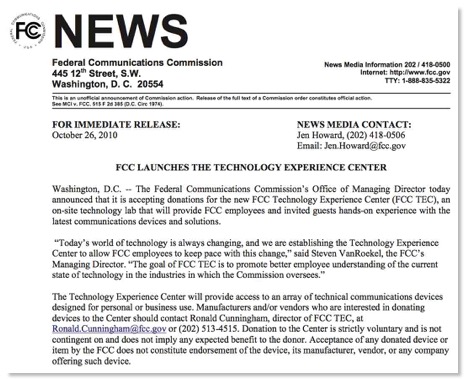
“It was the best of times, it was the worst of times” -- Tale of Two Cities
Yesterday FCC announced its new “Technology Experience Center” - “an on-site technology lab that will provide FCC employees and invited guests hands-on experience with the latest communications devices and solutions.” The underlying problem here is that FCC is really substantially underfunded and almost all of its budget goes to non-discretionary items like salaries, rent, and utilities. I recall many years ago hearing that FCC’s ratio of non-discretionary spending to total budget was one of the highest of any federal agency.
The FCC’s Lab and the Enforcement Bureau’s technical equipment spending is usually budgeted near zero at the beginning of each fiscal year in order to balance spending with the final appropriation and equipment is usually hurriedly selected and bought at the end of the fiscal year when it is determined how many crumbs are left over from the dominant non-discretionary part of the budget. (Since procurement rules expect competition for equipment procurement and there is usually not enough time for such competition, technical equipment purchases pragmatically must be limited to what is on GSA contract or items that DoD is buying in large quantity and allows other agencies to “ride the contract”. Sometimes this is the right equipment for FCC’s needs, sometimes it isn’t but it is the only equipment that can be bought in the fading light of the fiscal year in August.) But contrast, the WTB auctions operation has access to auction funds and is not limited to appropriated funds. During my years at FCC, every auctions staffer had a larger display on their CRT than every “normal” FCC employee as a sign of their superior budgetary status.

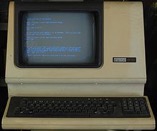
When Blackberries became the hit fad about 10 years ago, they were only available to the “elite” in FCC. As a mere SES techie, of course, I had no access to such technology even though my wife at DOE did. Thus I had to learn from her how these were changing the world. Needless to say mere GS-xx staffers - who were not intimates of the Chairman’s Office - also never had access to Blackberries and had to guess about their impact.
So the new FCC TEC is a pragmatic approach so that FCC staffers can see, touch, and use the technology that is changing our world and impacting communications.
But I hope it doesn’t divert attention about the serious underfunding of FCC with respect to its mission. One explanation I once heard from an FCC budget expert is that a root cause of the problem is that during the Reagan era there was a White House push to hold down spending but most agency heads pushed back against the biggest cutbacks. But then FCC Chairman Fowler and Managing Director Minkel were “true believers” in the Reagan Agenda and did not argue with OMB about cutbacks. Thus later when reason returned to federal budgeting and agencies were allowed to increase spending by a flat percentage, FCC was starting from a lower baseline and is still suffering from that lower baseline.
So for those who look back nostalgically on the Reagan years, many of FCC’s budget problems today date from that era.
FCC Again Honors Top Performing Staffers in Secret
Nevertheless, from sources on 12th Street, SW I have the list of those who received awards on October 18th in the Commission Meeting Room:
Gold Medal
- Val Brock, WCB
- Bill Cline, CGB
- James Higgins, EB
- Michael Wagner, MB
Silver Medal
- James Brown, WTB
- Barbara Cutts, IB
- Sandra Haase, OET
- Kim Mattos, OGC
I do not know several of these people, but I worked alongside Sandra Haase and Barbara Cutts in OET (and also when Barbara moved to IB). Both are apolitical civil servants who have worked for decades improving the FCC and its role.
I also worked closely with Jim Higgins in many points in my career both when I was exiled to EB’s predecessor, FOB, and while I was in OET and its predecessor. We first met during the spread spectrum rulemaking - which is the basis of Wi-Fi and Bluetooth now. Jim helped perform an experiment that confirmed that spread spectrum that is strong enough to cause interference could also be located with standard FCC equipment. (At the time the opponents of spread spectrum were creating also sorts of specious arguments to stop it.)
Jim Higgins and you blogger ca. 1992 in Hong Kong
to measure Chinese jamming of VOA

My congratulations to all the award winners.
I only hope that FCC reverses course here and publicly announces these awards and gives examples of the excellent work these people have done in the public interest. We should all be proud of such excellence!
UPDATE
I spoke with someone who knows all the medal winners this year who confirmed that they are all mid-level long term career civil servants and that none of them are particularly close to political appointees. In the past, high level political people have sometimes received these awards. Indeed, former Managing Director Minkel received the very first “Gold Medal” “at the insistence of the commissioners”.
I am impressed that the new team focused on apolitical career civil servants exclusively.
TAC is Back!
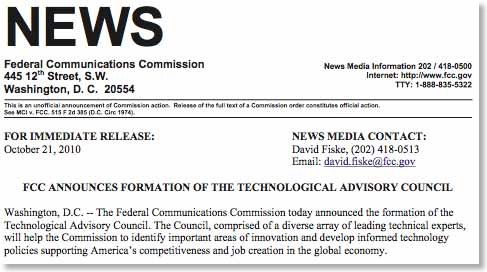
On October 21, FCC announced the returns of its only technical advisory committee, the Technological Advisory Council. The last meeting of the TAC had been July 20, 2006. The next meeting was cancelled on short notice and without any explanation. Rumor has it that Chmn. Martin was offended by a reported comment from one TAC member at an obscure IEEE conference and then questioned the “loyalty” of the TAC. FCC asked for nominations for its dormant TAC on April 8, 2009 and again on August 31, 2009. So almost 14 months after the second request the membership was named and the first meeting scheduled for November 4th.
The new chairman is Tom Wheeler, best known for having been head of CTIA. 38 other members were also named. Many hold the CTO title in their firms. It is somewhat difficult to classify precisely the background of each member since limited information was given. Certainly the Fortune 500 gang is well represented with people from Apple, HBO, Time Warner, Motorola, Fox, Microsoft, Qualcomm, Verizon, Intel, Comcast, AT&T, and Loral. 3 venture capitalists are represented. 6 academics are on the committee. On the political correctness front, there appear to be 2 women. It is hard to tell about minorities although the rumor mill indicated that was a priority. No one with an obvious East Asian name, but one possible South Asian.
There are several people from modest firms in the ISP and Internet-related equipment area. Surprisingly no one from the small to moderate sized wireless technology firms. This is especially odd when you really that most of the technical regulation at FCC is actually in the spectrum area, not in the Internet area.
We hope they look at the mess the NTIA CSMAC has made recently with its reports to date.
But the key question will be what will the TAC do this time around. In the past, certain top FCC officials were afraid to ask it anything about pending policy issues for fear it would detract from their own power. Thus the previous TAC was an intellectual debating society about irrelevant future issues. I hope that the Commission will ask it to address parts of policy issues that really have explicit answers. For example, is it possible for TDD to operate next to FCC mobile bands without harmful interference? How should one test cognitive radio units to see if they cause interference to conventional units? What will be the technical impact of repacking the TV bands?
I also urge members to read the definitive book from The Brookings Institution on how other agencies use technical advisory committees. Amazon has used copies for under $10.
ex parte R&O on Circulation

A recent review of the FCC’s Items on Circulation page revealed the surprising news that the ex parte rulemaking, Docket 10-43, was on circulation on the 8th Floor. While most of the FCC’s decisions are actually handled on circulation without public “discussion” at monthly meetings, it is unusual for such an initiative that was launched with great fanfare of transparency improvement to be suddenly shifted to the obscurity of circulation.
While the supporters of smoke filled rooms may be cheered by this move, those of us hoping that the new commissioners would keep to their pledges of transparency improvement are concerned.
Spectrum on Spectrum: Mitch Lazarus Writes About "The Great Radio Spectrum Famine"
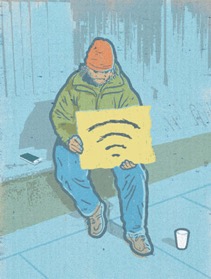
In the article, Mitch compares the technological evolution and spectrum efficiency improvements of fixed microwave, TV, cellular, and private land mobile spectrum. TV spectrum had a huge increase with the DTV transition, called “digital dividend” for good reason in Europe. Similarly, the cellular crowd has had tremendous efficiency improvements also. Fixed microwave, Part 101, once had an mandatory efficiency requirement of 1 b/s, but now has minimum data rates of 2.5 to 4.5 b/s . Private land mobile, Part 90, is stagnating by comparison:
Not until 1992 did the FCC launch a "refarming" program to cut the standard 25-kHz bandwidth to 12.5 kHz, with plans for a further trimming to 6.25 kHz. Twenty years later a lot of 25-kHz equipment is still in use, and the FCC-required implementation of 6.25-kHz equipment is still years away. Users, happy with their inefficient radios, resist government efforts to take them away. In the meantime, the goals of the program have been overtaken by technology. Doubling and quadrupling capacity may have been worth the effort in 1992, but such a target seems almost pointless today. Cellphone systems can carry 10 to 100 times the amount of voice traffic in the same amount of spectrum by using a dense network of towers and taking advantage of digital encoding and data compression.
Part 90 improvement has always been slow because local government licensees are always strapped for funds and use political pressure to press for myopic policies. The spectrum community has been unable to come up with realistic policies that compensate Part 90 users for increased spectrum efficiency in exchange for access to spectrum freed up.
Mitch offers a novel suggestion to break the logjam:
Any solution ultimately has to identify the least efficient or least critical services and redesign them to use less spectrum. Consider, for example, the current situation with two-way radios: 12.5 kHz for a one-way voice channel, with many channels vacant at any given moment. Such radios are indispensable to police, firefighters, and other emergency responders, as well as utility workers, taxi drivers, plumbers, construction crews, and many others. But their collective traffic could be handled in far less spectrum than is being used today. Unfortunately, there's no practical way to improve these devices on their present frequencies, beyond the long-awaited halving of their bandwidth.
We need to offer these people a more efficient alternative while making it more costly for them to use their old equipment. Suppose the FCC gave a nonprofit industry group a few megahertz in which to provide efficient, digital, two-way radio service on an at-cost basis. To be sure, many users would prefer to keep their existing radio gear. But the FCC could make their licenses more expensive and equipment requirements more demanding, while pointing users to the new collective service as a better option.


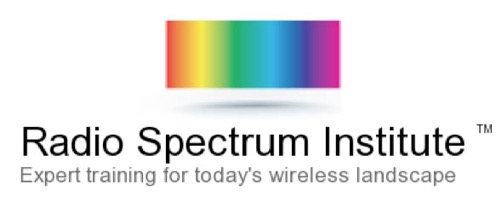


![Validate my RSS feed [Valid RSS]](valid-rss-rogers.png)

